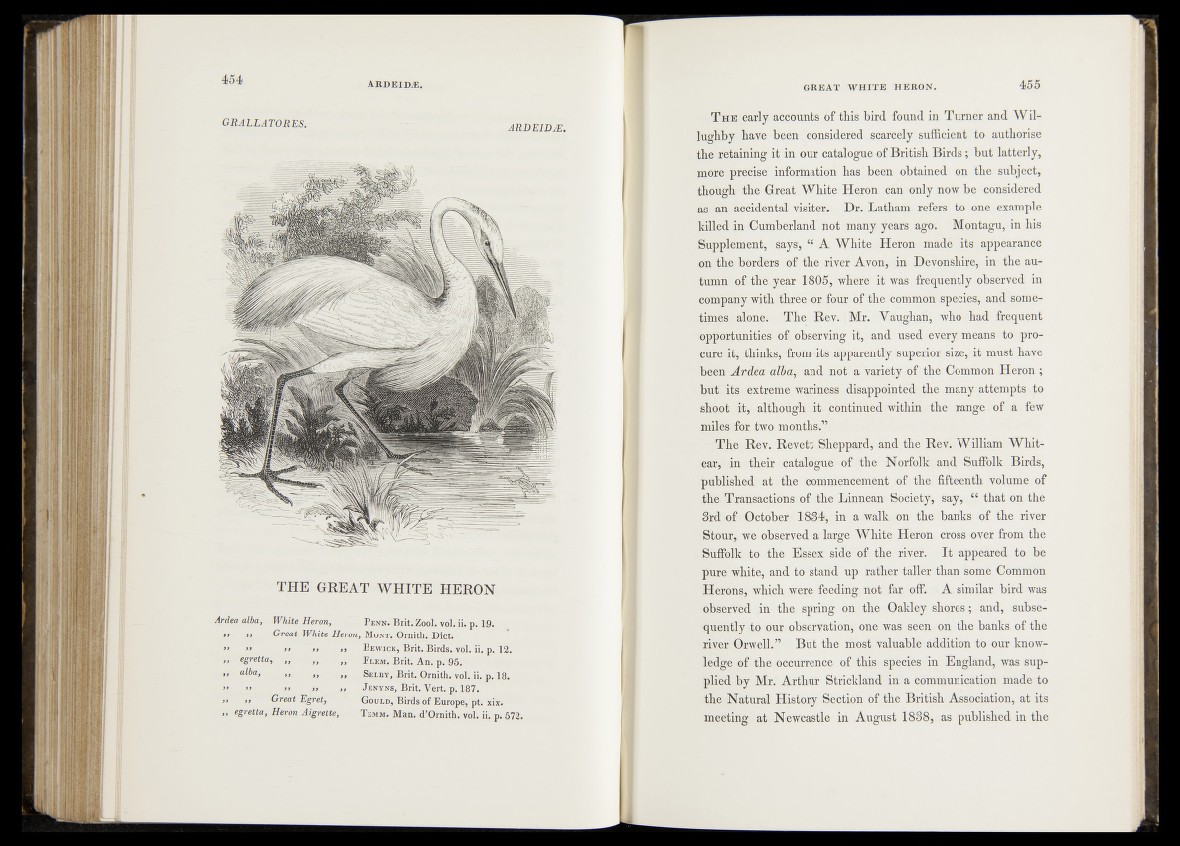
GRALLATORES. ARBEID Æ.
T H E GREAT W H IT E HERO N
Ardeaalba, WbM Heron, Penn. Brit. Zool. vokiu p. 19.
»> - »> Great White Heron, Mont. Ojnith.Dict.
*• ” >• " >» » Bewick, Brit. Birds, vol. ii. p. 12.
„ egretta, „ „ Plem. Brit. An. p. 95.
„ alba, „ „ ,, Selby, Brit. Ornith. vol. ii. p. 18.
» . ” ** j > »> Jenyns, Brit. Vert, p. 187.
>> >> Great Egret, Gould, Birds of Europe, pt. xix.
» egretta, Heron Aigrette, Temm. Man. d’Omith. vol. ii. p. 572.
T he early accounts óf this bird found in Turner and W il-
lughby have been ^considered scarcely sufficient to authorise
the retaining it in our catalogue of British Birds; but latterly,
more precise information has been obtained on the subject,
though the Great White Heron can only now be considered
as an accidental visiter. Dr. Latham refers to one example
killed in Cumberland' not many'years ago; Montagu, in his
Supplement, - says, “ A White Heron made its appearance
on the borders of the river Avon, in Devonshire, in the autumn
of the-year 1805, where it was frequently observed in
company with three or four of the common species, and sometimes
alone. The Rev.'jjMr. Yaughan, who had frequent
opportunities of observing it, and used every means to procure
it, thinks, from 'its apparently superior size, it must have
been Ardea alba, and not a variety of the' Common Heron ;
but' its .extreme wariness disappointed the many attempts po
shoot it, although- it continued within the Tange of a few
miles for two months.1’/
~ The Rev. Revett Sheppard* and the Rev. William Whit-
ear, in their catalogue fof the Norfolk -and Suffolk Birds,
published at the commencement of the fifteenth volume of
the Transactions of the Linneam Society, say, that on the
3rd of October «1834, in a walk on the banks of the river
Stour, we observed a large White Heron cross over from the
. Suffolk(i© »the Essex side of the river. I t appeared to be
pure white, and to stand up rather taller than some Common
Herons, which were feeding not far off. A similar bird was
observed in the spring on the Oakley shores; and, subsequently
to our observation, one was seen on the banks of the
river Orwell.” But the móst valuable addition to our knowledge
of the occurrence: of this species in England, was supplied
by Mr. Arthur Strickland in a communication made to
the Natural History Section of the British Association, at its
meeting at Newcastle in August 1838, as published in the